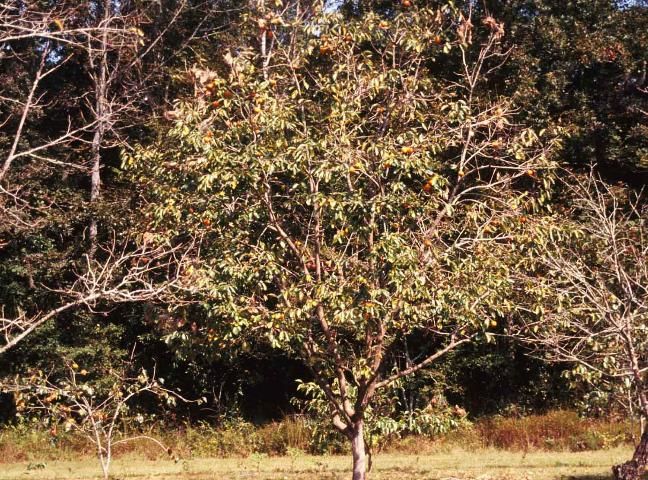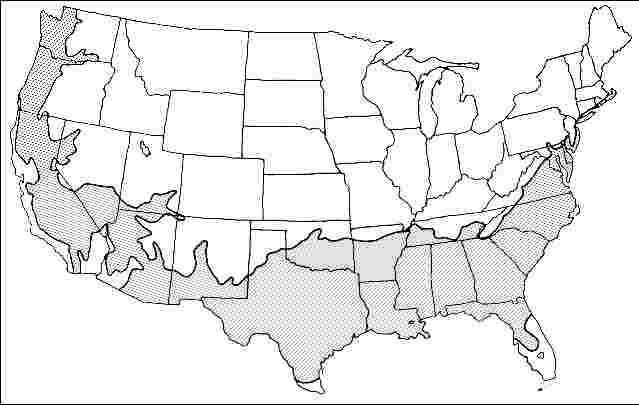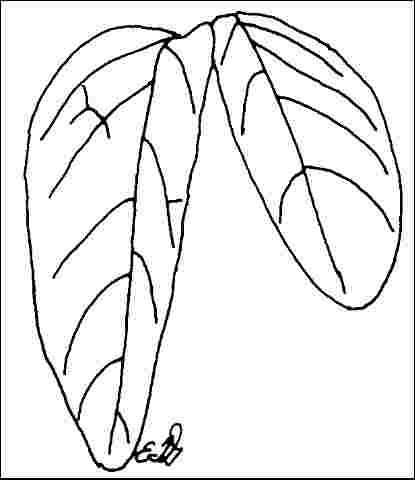Introduction
Japanese persimmon is a species related to common persimmon (Diospyros virginiana), but is native to Asia (China, Japan). It can grow to about 30 feet when mature. This is an excellent fruit tree for ornamental use and makes an excellent specimen. The tree is a sight to behold when leaves have fallen in autumn, displaying the bright yellow-orange fruits throughout the canopy. Similar to common persimmon, its preference is for a moist, well-drained soil in full sun locations. The tree has good drought tolerance. Japanese persimmon develops an attractive red fall color, but the 2- to 4-inch-diameter fruits can be a big mess when they fall from the tree.

Credit: Ed Gilman, UF/IFAS
General Information
Scientific name: Diospyros kaki
Pronunciation: dye-OSS-pih-ross KACK-eye
Common name(s): Japanese persimmon
Family: Ebenaceae
USDA hardiness zones: 7A through 9A (Fig. 2)
Origin: not native to North America
Invasive potential: little invasive potential
Uses: container or planter; fruit; specimen
Availability: somewhat available, may have to go out of the region to find the tree

Description
Height: 20 to 30 feet
Spread: 15 to 25 feet
Crown uniformity: symmetrical
Crown shape: upright/erect, round
Crown density: dense
Growth rate: moderate
Texture: coarse
Foliage
Leaf arrangement: alternate (Fig. 3)
Leaf type: simple
Leaf margin: serrate, entire
Leaf shape: elliptic (oval), obovate
Leaf venation: pinnate, brachidodrome
Leaf type and persistence: deciduous
Leaf blade length: 4 to 8 inches
Leaf color: green
Fall color: yellow, orange, red
Fall characteristic: showy

Flower
Flower color: white/cream/gray
Flower characteristics: not showy
Fruit
Fruit shape: oval, round
Fruit length: 3 to 6 inches
Fruit covering: fleshy
Fruit color: orange
Fruit characteristics: attracts squirrels/mammals; showy; fruit/leaves a litter problem
Trunk and Branches
Trunk/bark/branches: branches droop; not showy; typically multi-trunked; thorns
Pruning requirement: little required
Breakage: resistant
Current year twig color: brown, gray
Current year twig thickness: medium
Wood specific gravity: unknown
Culture
Light requirement: full sun
Soil tolerances: clay; sand; loam; acidic; alkaline; well-drained
Drought tolerance: moderate
Aerosol salt tolerance: low
Other
Roots: not a problem
Winter interest: no
Outstanding tree: no
Ozone sensitivity: unknown
Verticillium wilt susceptibility: susceptible
Pest resistance: resistant to pests/diseases
Use and Management
Certainly not a street or parking lot tree, Japanese persimmon is probably best located as an occasional specimen where it can be viewed from a distance, away from walks. This will ensure that the fruit will drop on the lawn, not on a walk. Better yet, plant the tree in a loose, low-growing groundcover so dropping fruit will be hidden from view in the foliage of the groundcover.
Some non-astringent cultivars have been selected and could be available locally.
Pests and Diseases
A trouble-free tree, but messy in fruit.